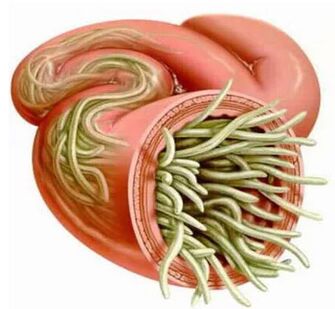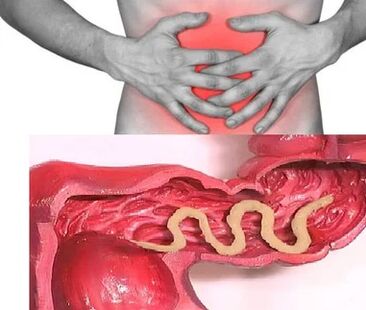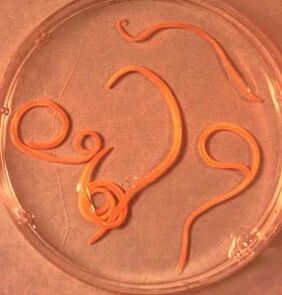So far, science is known for over 280 types of worms that can develop and live in the human body and can parasitize in various organs and tissues.The frequency of human infection depends on the climatic and socio -economic conditions of certain areas (in underdeveloped countries, especially in patients in tropical and subtropical zone, this is much higher than in economically developed states).
Methods of human infection with helminthen:
- Biumelmintosis (infection of animals).
- Contagioine Helminthoses (transferred from person to person).
- Geoögelmintoses (diseases caused by parasites that carry out one of the vital cycles in the earth).

Factors that influence the manifestations of helminthia
The method for penetrating the parasite in the body:
- The degree of adaptation of helminths to the human body;
- The density of the population (amount) parasitic individuals;
- The worm habitat (fabric parasites live in the thickness of the soft tissue, and the clearing live in the gaps of the hollow organs).Some helminths in different phases have educational and fabric shapes.The larvae and development stages of worms usually cause stronger pathological changes.
In the absence of a RE -IN function, the number of adult parasites in the human body does not increase.This characteristic distinguishes helminthic invasions of diseases caused by bacteria, viruses, fungi and simple organisms.
Worms in humans: symptoms
Helmintile is a disease that is characterized by 2 stages of the course (from two weeks to two months) and chronic (from several months to several years).
Symptoms of an acute phase of helminthiasis
The first signs of the disease can manifest themselves in different times (mostly after 2-3 weeks, ascaridosis for 2-3 days and with phylairiosis, the incubation period can take 6-18 months).
In the acute stage of the parasitic invasion, the most characteristic symptom is an allergic reaction (antibodies are generated by wandering larvae of parasites).Often itchy rashes, susceptible to the recurring course, an increase in the recurring course, the regional lymph nodes occur on the skin, and the occurrence of generalized or local edema, muscles and joint pain can occur.Migrating larvae of the parasite can also cause pain in the chest, cough, suffocation, stool disorders, nausea and vomiting.
At the same time, the acute phase of helminthiasis can be accompanied by more serious disorders (severe forms of pneumonia, hepatitis, allergic myocarditis, hepatosterogalia (an increase in liver and spleen).
In the blood, the amount of eosinophilic (eosinophilia) increases and the normal quantitative ratio between protein fractions (dyproteinemia) has been disturbed.

Signs of chronic helminthiasis
The symptoms of the chronic phase directly depend on which organ is "populated" with parasites, as well as their size and quantity play an important role.
If the disease in the intestine of individuals is parasitic, it can occur asymptomatic (with the exception of infections with very large parasites).The characteristic characteristics of the chronic phase of the intestinal helmet theater are dyspeptic disorders.Acenoarotic and pain syndrome is more pronounced in children.In the case of massive invasion carids, intestinal deflection, mechanical jaundice and pancreatitis is possible.
By consuming all substances required for their vital activity from the body of the host, helminths cause digestive disorders, violations of the absorption of vitamins, minerals, carbohydrates, proteins and fats.At the same time, the products of the lifespan of worms inhibit the normal intestinal mroflora and reduce the body's immune powers.
In people who suffer from Helmintias, the risk of malignant tumors increases significantly due to the weakened immunity and the increased process of cellular division (consequences of constant restoration of tissue parasites).
Types of helminthen parasitically in the human body
The causal means of human helminthiasis are 2 types of worms: round (nematodes) and flat (band and subtasks).
Round worms
Eyelash
Parasites that are the cause of the enterobiosis are small (up to 10 mm) thin cavity worms with gray -white spots.The infection occurs on digestible (through the mouth).The reason for this is dirty hands.Eggs of the parasite can be in the ground on which wool infected animals, unwashed vegetables and fruit, etc. are.The cutting larva develops in the digestive tract within two weeks.The worm is parasitically parasitically in an adult individual in the lower and upper parts of the large intestine.

Askarida
Askarid is a large parasite of a spindle-shaped shape of the red-yellow color that reaches an adult state of 40 cm (women) and 15-25 cm (men).Without suction cups or other fixing devices, Ascarid can move independently towards the food masses.Eggs that were laid down by the female parasite are distinguished with feces.
The acadosis infection occurs when swallowing mature eggs together with water or unwashed vegetables and fruit on which floor particles are available.After the eggs had penetrated the intestine, they come out of them maturated larvae.Then they reach the heart into the intestinal wall after blood flow and fall into the lungs from there.Due to the pulmonary alveola, the Larve of the Ascarida penetrates the oral cavity through the airways.After repeated swallowing, the parasite reaches the small intestine, where it develops into an adult.The worm lives for 12 months, then dies and stands out with feces.One or more hundred people can live in the intestine of an owner.
Vlashev
Vlasov, the causal means of the trichocephalose, is a white helminth that parasitates in the first part of the large intestine and reaches a size of 4 to 5 cm.The parasite is fed by the blood and tissues of the rectal mucosa.
The eggs with the kots on the intestinal walls.Their development is carried out in the environment (optimally in the ground).Eggs with parasite larvae are penetrated into the body with a serious way, through dirty hands, with water or unwashed vegetables and fruit.

Trichinella
The causal means of trichinellosis is a small round helminth that reaches 2-5 mm long.Infection occurs when the use of poorly fried meat (pork, bear boy, wild boar) is used.The parasite larva in the intestine in 3-4 days turns into the state of the sexually mature individual.The life expectancy of the worm is 40 days that the parasites die.Larvae drive the intestinal wall and penetrate into the bloodstream and are worn in all organs of the human body and settle in the muscles.In this case, the breathing and facial muscles as well as the muscles ado bends of the limbs are most often affected.
In the first days after the invasion, patients complain of abdominal pain.After about 2 weeks, the body temperature rises to 39-40 s, itchy rashes occur on the skin, muscle pain develops and the face swells.During this period there is a considerable risk of death in massive infections.The recovery occurs after about a month.The parasite is encapsulated in spiral shape, according to which it dies within two years.
Ankylostoma and not core
These two parasites are similar through biological characteristics and in the diseases caused.It is common to combine it under the general name (Ankylostoma).Worms that reach the lengths of 10 to 15 mm are parasitic in 12-p.Colon.It should be noted that this is one of the most common, but at the same time rarely identified parasites.Worms of worms penetrate into the human body through the skin when they are in contact with infected soil.In addition, like Ascarides, they hike into the bloodstream and hike into the lungs just like ascarides and then through the Bronchi together with the Hoping sputum - to the digestive tract.Anquilostoms parasitically in the intestine and attach to the intestinal wall.A parasite that eats exclusively with the blood bites the blood vessels that penetrate the mucosal membrane, and injects an anti -not -mated component.During the day, an adult can absorb blood an average of 0.05-0.35 ml.Therefore, the most characteristic symptom of this helminthiase is iron deficiency anemia and a change in the ratio of protein fractions (dyproteinemia).
Flat worms
Wide adhesive tape
This is one of the largest helminths that reach a length of 10 to 20 meters.The disease caused by this parasite is called dipillobotriosis.The worm development cycle begins with freshwater fish or crustaceans.The larva enters the human body, which is the last owner of a wide band with a caviar or infected fish fillet.The parasite is attached to its wall and grows to a sexually mature individual for 20 to 25 days.
Hepatic bacon
A parasite that causes opisthorchiasis is a flat worm that reaches a length of 7 to 20 mm.It should be noted that more than 50% of the infection cases with a liver base cup (it is also known as a cat biconomist) falls on the residents of Russia.The parasite larvae begin to develop after the eggs fall into fresh water (from the swallowed snails).Then penetrate into the body of the fish (carp, cross carp, brags, cockroach).Human infection occurs when you eat infected fish meat that has not subjected sufficient heat treatment.The larva of the liver bomb from the small intestine penetrates the bile ducts into the gallbladder and repairs there with two suction cups.
Bull and pork
These parasites, which are almost identical in the structure, reach a length of 5 to 6 meters.Infection with tusiarin pants and tusiasis is based on the use of cattle or pork that are infected with Finn (one of the intermediate forms of helminthiasis).The visible fins, which are presented in the form of whitish blisters and reach a size of 0.5 cm, are attached to the wall of the small intestine of a person and become an adult individual in 3 months.The strip parasite, consisting of more than 2000 segments, is constantly growing.At the same time, the egg segments that contain eggs go off and move into the anal opening independently and then crawl out of anal or lift themselves into the outer environment with feces.The most characteristic symptoms of helminthiasis are a violation of the digestive tract.
Echinococcus
For this parasite, one person is an intermediate floor.The worm parasitates in the human body in the form of Finn.The last owner of Echinococcus is a wolf, a dog or a cat.The infection is in contact with animals and environmental objects with the handful of Echinococcus eggs.After entering the intestine, oncospheres (six black larvae) develop from them.They enter the bloodstream from the intestine and are worn throughout the body.
Alveocock
This parasite, which is seen as a variety of echinococci, is the cause of one of the most dangerous helminthia (alveococcosis), which is similar in severity with cirrhosis and liver cancer.The infection occurs with the penetration of oncosphere (eggs with mature larvae) into the intestine.There the embryo comes out of the egg and, installed in the intestinal walls, penetrates into the bloodstream.In addition, the parasite spreads through all tissue and organs of the body (most often located in the liver).The main level of development on the larvae (a multi -chamber bladder, Laurelozyst) begins there.Each chamber contains an embryo head of a parasite that continues to develop.Lavrocists are very aggressive formations that constantly grow due to increasing bubbles and have the ability to germinate cancer metastases into the liver.
Diagnosis of helminthiasis
The diagnosis of helminthian invasions includes the following events:
- A thorough collection of an anamnesis that contributes to finding out the possible causes of infections;
- Laboratory studies of faeces, blood, content of 12p -intestine, rectal and perianal mucus, muscle tissue, lung sputum, bile.Eggs, segments or fragments of parasites can be detected during the analysis.At the same time, the increased content of eosinophils in the blood is also a signal about the presence of helminthiasis.
- In the diagnosis of diseases caused by the larval stages or tissue parasites, serological studies (ELISU, RSC, indirect agglutination, immune fluorescence analysis, etc.) are carried out.
- In order to identify helminths that influence the liver tissue, ultrasound, CT and endoscopic studies are prescribed.
Worms in humans: treatment
In the acute phase of parasitic infection, the patient is prescribed detoxification and desensitization therapy.In a severe course of illness (liver trematodosis, trichinellosis), glucocorticoids are used according to medical indications.
Special anthelmine chemotherapy agents are prescribed as medication specific therapy, taking into account the type of pathogen.
At the same time, the patient is recommended to take antihistamines and enteroses.The final treatment phase includes the use of probiotics that normalize the intestinal microflora.
A special saving diet is also prescribed (food should be easy to digest and contain little fat).
During the time of anthelmin therapy, the patient needs strict compliance with personal hygiene (to avoid re -i infection).At the same time, all family members and people who are infected in constant contact should be treated with many helminthiasis.























